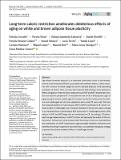Por favor, use este identificador para citar o enlazar a este item:
http://hdl.handle.net/10261/188826COMPARTIR / EXPORTAR:
 SHARE SHARE
 CORE
BASE CORE
BASE
|
|
| Visualizar otros formatos: MARC | Dublin Core | RDF | ORE | MODS | METS | DIDL | DATACITE | |

| Título: | Long‐term caloric restriction ameliorates deleterious effects of aging on white and brown adipose tissue plasticity |
Autor: | Corrales-Cordón, Patricia; Vivas, Yurena; Izquierdo Lahuerta, Adriana; Horrillo, Daniel; Seoane-Collazo, Patricia; Velasco, Ismael; Torres, Lucia; López, Yamila; Martínez, Carmen; López, Miguel; Ros, Manuel; Obregón, María Jesús CSIC ORCID ; Medina, Gema CSIC ORCID CVN | Palabras clave: | Adipose tissue Aging Caloric restriction Fibro‐inflammation Insulin resistance Thyroid hormone |
Fecha de publicación: | 2019 | Editor: | Anatomical Society of Great Britain and Ireland John Wiley & Sons |
Citación: | Aging Cell 18(3): e12948 (2019) | Resumen: | Age‐related increased adiposity is an important contributory factor in the development of insulin resistance (IR) and is associated with metabolic defects. Caloric restriction (CR) is known to induce weight loss and to decrease adiposity while preventing metabolic risk factors. Here, we show that moderate 20% CR delays early deleterious effects of aging on white and brown adipose tissue (WAT and BAT, respectively) function and improves peripheral IR. To elucidate the role of CR in delaying early signs of aging, young (3 months), middle‐aged (12 months), and old (20 months) mice fed al libitum and middle‐aged and old mice subjected to early‐onset CR were used. We show that impaired plasticity of subcutaneous WAT (scWAT) contributes to IR, which is already evident in middle‐aged mice. Moreover, alteration of thyroid axis status with age is an important factor contributing to BAT dysfunction in middle‐aged animals. Both defects in WAT and BAT/beige cells are ameliorated by CR. Accordingly, CR attenuated the age‐related decline in scWAT function and decreased the extent of fibro‐inflammation. Furthermore, CR promoted scWAT browning. In brief, our study identifies the contribution of scWAT impairment to age‐associated metabolic dysfunction and identifies browning in response to food restriction, as a potential therapeutic strategy to prevent the adverse metabolic effects in middle‐aged animals. | Versión del editor: | https://doi.org/10.1111/acel.12948 | URI: | http://hdl.handle.net/10261/188826 | DOI: | 10.1111/acel.12948 | ISSN: | 1474-9718 | E-ISSN: | 1474-9726 |
| Aparece en las colecciones: | (IIBM) Artículos |
Ficheros en este ítem:
| Fichero | Descripción | Tamaño | Formato | |
|---|---|---|---|---|
| longplasti.pdf | 1,73 MB | Adobe PDF |  Visualizar/Abrir |
CORE Recommender
PubMed Central
Citations
21
checked on 04-abr-2024
SCOPUSTM
Citations
38
checked on 16-abr-2024
WEB OF SCIENCETM
Citations
35
checked on 28-feb-2024
Page view(s)
299
checked on 23-abr-2024
Download(s)
168
checked on 23-abr-2024

